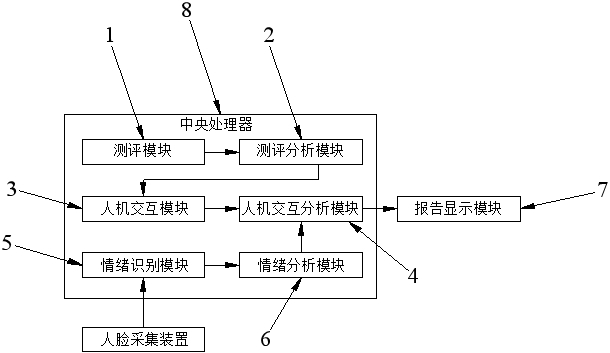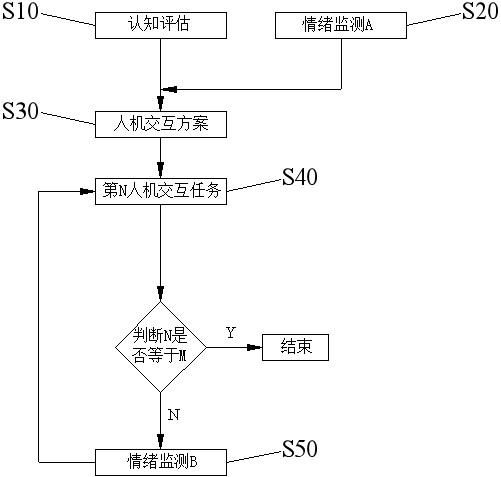Cognitive disorder man-machine interaction method and system based on emotion monitoring
A technology of human-computer interaction and cognitive impairment, applied in the field of human-computer interaction, can solve problems such as the inability to evaluate or interfere with the impact, and achieve the effect of improving the interaction effect
- Summary
- Abstract
- Description
- Claims
- Application Information
AI Technical Summary
Problems solved by technology
Method used
Image
Examples
no. 1 example
[0077] Please refer to figure 2 As shown, the human-computer interaction method for cognitive impairment based on emotion monitoring specifically includes the following steps:
[0078] S10. Obtaining the cognitive ability level of the user
[0079] The user information is obtained, so as to perform cognitive evaluation on the user according to the obtained evaluation topic, and obtain an evaluation result of the user.
[0080] As shown in reference 3, it specifically includes steps S101-S103:
[0081] S101. Obtain user information and user informed consent to implement login.
[0082] Specifically, users need to register an account in advance, and obtain a login account by entering personal information, so that they can log in to the human-computer interaction system for cognitive disabilities. Among them, the user's informed consent specifically includes: evaluation, introduction of human-computer interaction content, user information collection scope, user information us...
no. 2 example
[0145] refer to Figure 9 As shown, in the above human-computer interaction method for cognitive impairment, the following steps are also included after step S40:
[0146] S40A. During the human-computer interaction process, a relaxed human-computer interaction is performed between two adjacent human-computer interaction tasks, and the task type of the relaxed human-computer interaction is selected according to the user's emotional comprehensive index in the previous human-computer interaction task.
[0147] The specific selection rules are shown in Table 4:
[0148]
[0149] Table four
[0150] When the emotional comprehensive index is positive, the human-computer interaction task chooses high-intensity challenge tasks; when the emotional comprehensive index is negative, the human-computer interaction task chooses high relaxation and decompression tasks; when the emotional comprehensive index is neutral, then Human-computer interaction tasks are randomly selected from th...
no. 3 example
[0154] Please refer to Figure 10 As shown, the difference between this embodiment and the second embodiment is that in this embodiment, the user conducts emotion monitoring (namely, emotion monitoring C) when the user performs relaxation interaction, and at the same time, the emotional synthesis obtained during the relaxation interaction The index is used as the basis for pushing the next human-computer interaction task.
[0155] Specifically, in this embodiment, after the previous human-computer interaction task is completed, the user will enter the relaxation interaction mode. During the relaxation interaction process, the user's relaxation interaction mode can be obtained by monitoring the user's emotion (that is, emotion monitoring C). Emotional comprehensive index in the process. Finally, the user’s human-computer interaction result of the previous human-computer interaction task is combined with the user’s emotional comprehensive index in the process of relaxing interac...
PUM
 Login to View More
Login to View More Abstract
Description
Claims
Application Information
 Login to View More
Login to View More - R&D
- Intellectual Property
- Life Sciences
- Materials
- Tech Scout
- Unparalleled Data Quality
- Higher Quality Content
- 60% Fewer Hallucinations
Browse by: Latest US Patents, China's latest patents, Technical Efficacy Thesaurus, Application Domain, Technology Topic, Popular Technical Reports.
© 2025 PatSnap. All rights reserved.Legal|Privacy policy|Modern Slavery Act Transparency Statement|Sitemap|About US| Contact US: help@patsnap.com



